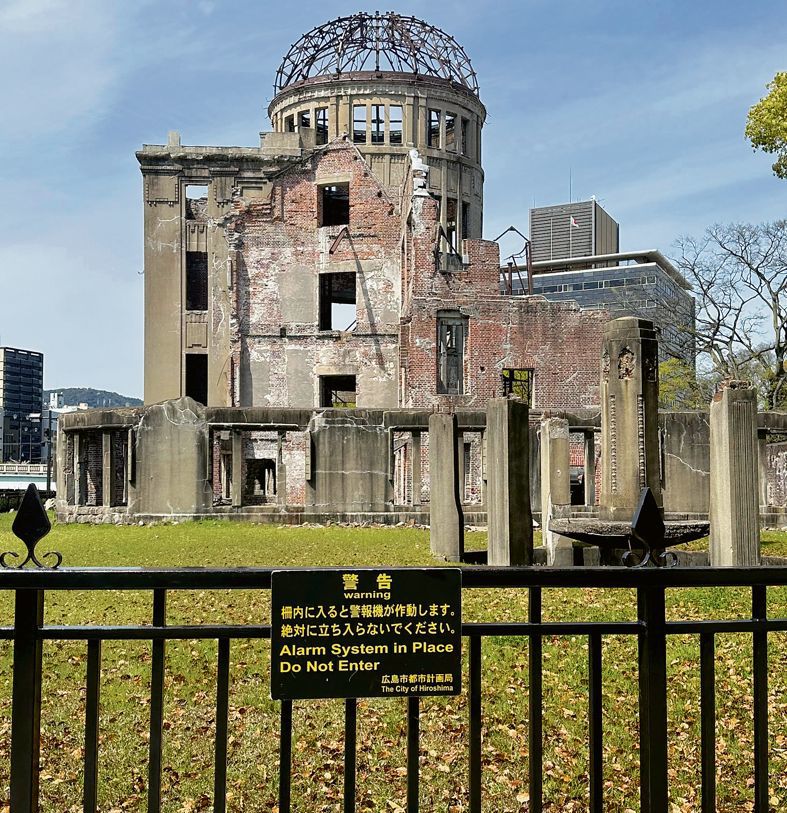TRAGEDY TO TRIUMPH: Hiroshima, which was bombed on August 6, 1945, will stir your soul. It symbolises Japan’s resilience
Sujata Rajpal
Drenched in catastrophe yet vibrant with hope, Hiroshima, located in the southwestern part of Honshu Island, Japan, is a testament to human resilience. In the Peace Memorial Park stands the imposing Atomic Bomb Dome. Once Hiroshima Prefectural Industrial Promotion Hall, the dome is the only building that partially survived the bombing on August 6, 1945. Rightfully designated as a UNESCO World Heritage site, it serves as a reminder of the perils of nuclear weapons. The skeletal remains of the building, standing against the backdrop of a serene city, make the horrors of the day feel incredibly real. We were so absorbed in the moment that we didn’t think it appropriate to pose in front of the monument.
Spread across a vast expanse of greenery and flowing fountains, the Peace Memorial Park, dedicated to Hiroshima’s legacy as the first city to suffer atomic bombing, is peppered with numerous monuments, each a poignant reminder of the calamity that had annihilated this city. In the centre of the park, the Flame of Peace burns continuously as a resolve to make this world free of nuclear weapons.
TRAVEL TIPS
- The best way to travel to Hiroshima from anywhere in Japan is by Shinkansen (bullet train).
- From Kyoto, it takes 1.5 hours.
- From Hiroshima station, board the red Hop-on Hop-off bus, which is free for Japan Rail pass holders. For the non-pass holder, the fare is nominal.
Next to it, a concrete saddle-shaped monument covers an edifice holding the names of the people killed in the bombing. The Children’s Peace Monument commemorates Sadako Sasaki and thousands of children who died due to the bombing. Sadako survived but lost her life 10 years later to leukaemia caused due to exposure to radiation. Her mission was to fold 1,000 paper cones in the hope of recovery. Clutching one of the countless cranes left by visitors, I felt an intimate bond with her story.
In the seminar hall, a 20-minute documentary on the account of the survivors brought alive the calamity. When the film ended, there was not a single dry eye. The Peace Memorial Hall below provides a 360º view of the city after the blast. The cylindrical-shaped hall has nearly 1,40,000 tiles, the approximate number of people who had died by the end of 1945, one each for every victim. Many who survived the bombing later died of leukaemia. Silence permeated the hall. The only sound was that of water flowing from a fountain, signifying the victims who died crying for a drop of water to soothe their parched throats.
On display at the Hiroshima Peace Memorial Museum are artefacts and belongings of victims and survivors, like a kid’s bicycle, a toy that must have fallen from tiny hands. But for the museum, entry everywhere within the Peace Memorial Park is free, reinforcing that Japan urges its public to visit Hiroshima.
Standing in front of each monument, gaping, reading the epitaph, a silent gloom envelops. As you step out of the Park, the city is abuzz with symbols of a developed world, narrating a story of rebirth. “After the bombing, the soothsayers had prophesied that nothing would grow on Hiroshima’s earth for 75 years but look at this lush green garden with colourful flowers and tall trees,” said the guide at Shukkeien Garden, with its beautifully manicured landscapes and tranquil ponds.
A visit to Hiroshima wouldn’t be complete without indulging in Hiroshima-style okonomiyaki, a savoury pancake layered with noodles, seafood and vegetables, cooked on a hot griddle.
The bombing was a crime against humanity, but sadly, the bigger crime is that countries even today fail to learn from the mistakes, mindlessly crushing lives, livelihoods and dreams.
Hiroshima isn’t a destination; it’s an experience that promises to stir your soul and ignite awe over a country’s resilience.









